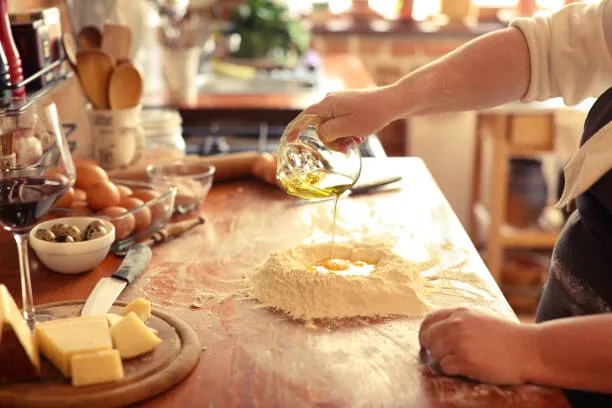The main types of flour used for pasta are hard-durum wheat flour, semolina, and hard winter wheat.
A mix of more than one type of flour is what’s called an alternative flour for pasta.
Adding pastes or purees to pasta is a new phenomenon.
Dried Pasta And Durum Wheat Semolina
A dried pasta made from semolina.
Semolina has more strength than other wheat flour and it behaves differently, making it the logical choice for dried pasta.
Semolina’s gluten doesn’t turn into a loose boiled dough when you cook it because it doesn’t stretch like other types.
Semolina pasta is a true Italian staple because of its versatility and ability to reach the coveted al dente stage where it is soft on the outside with a hint of a bite at the center.
Make sure the pasta you buy is made from durum wheat semolina.
Bread Flour and Fresh Pasta
Fresh pasta is made from the flour of hard wheat varieties.
The high content of wheat in bread flour makes it different from semolina.
Despite its name, hard wheat flour has a lot of elasticity and stretches more than semolina, which limits its strength.
You can never cook fresh pasta to a firm, toothy al dente stage, and it turns to mush faster when you overcook it.
Fresh pasta is limited, but it has its place.
Fresh squid ink pasta dressed with garlic and olive oil is impossible with dried pasta, and other dishes rely on its smooth, soft texture.
Flavored Pasta Flour Types
The puree or paste of the flavoring ingredient is used in the production of pasta like a tomato.
bread flour is used for fresh noodles while semolina is used for dried pasta.
You can make your own fresh pasta by pureeing 1 cup of the vegetable of your choice and mixing it with one additional egg yolk after it cools.
The egg yolk should be added to a fresh pasta recipe.
Alternative Pasta Flours
Rice- and egg-based pasta are used in Asian cooking and are usually whole-wheat and gluten-free.
The flour in whole-wheat pasta is usually ground from a combination of whole and hulled hard wheat, which is difficult to digest.
Small shops and specialty shops make small batches of artisanal pasta from a variety of grains.
Read More: Difference Between Gouda & Gruyere Cheese?
Related: Gouda vs. Munster Cheese
Related: 5 Popular French Foods in America
